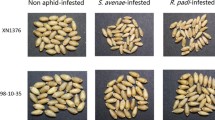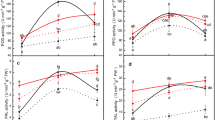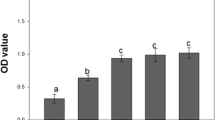Abstract
Cotton aphids (Aphis gossypii Glover) are important pests of cucurbit crops. Plant defenses at different cell layers, including the leaf surface, mesophyll cells, and phloem, are employed to defend aphids. Here, we assessed differences in aphid resistance among six watermelon varieties and elucidated the defense mechanisms underlying aphid-resistant/susceptible watermelon varieties. The population abundance, offspring number per female, and meantime of phloem-feeding (E2 phase) of aphids were the highest on XiNong (XN), followed by JingXin (JX), TianWang (TW), ZaoJia (ZJ), and MeiFuLai (MFL), and these parameters were the lowest on JinMeiDu (JMD). Further analyses showed that there was no correlation between the aphid resistance of six watermelon varieties and defenses at the leaf surface. For defenses at mesophyll cells, aphid infestation increased salicylic acid (SA) content at 48 h post-infestation (hpi) and ROS accumulation at 6 and 12 hpi in six watermelon varieties. For phloem defenses, aphid infestation increased callose content in JMD plants but decreased callose content in JX, TW, ZJ, MFL, and XN plants at 6, 12, 24, and 48 hpi. Moreover, callose deposition suppressed by 2-deoxy-d-glucose (2-DDG) neutralized the resistance of JMD plants and exacerbated the susceptibility of XN plants to aphids, which exhibited a higher population abundance and E2 phase time. Collectively, phloem defenses regulated by aphid-induced callose deposition were responsible for differences in aphid resistance among the watermelon varieties.








Similar content being viewed by others
Data availability
The data that supports the findings of this study is openly available in figshare at https://doi.org/https://doi.org/10.6084/m9.figshare.19697335.
References
Alvarez A, Tjallingii W, Garzo E, Vleeshouwers V, Dicke M, Vosman B (2006) Location of resistance factors in the leaves of potato and wild tuber-bearing Solanum species to the aphid Myzus persicae. Entomol Exp Appl 121:145–157. https://doi.org/10.1111/j.1570-8703.2006.00464.x
Archer L, Mondal HA, Behera S, Twayana M, Patel M, Louis J, Nalam VJ, Keereetaweep J, Chowdhury Z, Shah J (2023) Interplay between MYZUS PERSICAE-INDUCED LIPASE 1 and OPDA signaling in limiting green peach aphid infestation on Arabidopsis thaliana. J Exp Bot 74:6860–6873. https://doi.org/10.1093/jxb/erad355
Backus EA, Shugart HJ, Gutierrez J, Ebert TA, Walker MA (2021) Field-collected glassy-winged sharpshooters (Hemiptera: Cicadellidae) perform more Xylella fastidiosa-inoculating behaviors on susceptible Vitis vinifera cv. “Chardonnay” than on resistant Vitis champinii grapevines. J Econ Entomol 114:1991–2008. https://doi.org/10.1093/jee/toab141
Boissot N, Schoeny A, Vanlerberghe-Masutti F (2016) Vat, an amazing gene conferring resistance to aphids and viruses they carry: from molecular structure to field effects. Front Plant Sci 7:1420. https://doi.org/10.3389/fpls.2016.01420
Botha AM, van Eck L, Burger NF, Swanevelder ZH (2014) Near-isogenic lines of Triticum aestivum with distinct modes of resistance exhibit dissimilar transcriptional regulation during Diuraphis noxia feeding. Biol Open 3:1116–1126. https://doi.org/10.1242/bio.201410280
Chen MC (2018) Identification of the proteins related to cucumber resistance to aphid by proteomics analysis (Cucumis sativus L.). Master's dissertations. Yangzhou University, Yangzhou
Chen Q, Liang X, Wu CL, Liu Y, Xu XL (2020) Genetic analysis of resistance of watermelon cultivars ‘Heipi’ to Aphis gossypii. Chin J Trop Crops 41:1415–1419. https://doi.org/10.3969/j.issn.1000-2561.2020.07.018
Coppola M, Manco E, Vitiello A, Di Lelio I, Giorgini M, Rao R, Pennacchio F, Digilio MC (2018) Plant response to feeding aphids promotes aphid dispersal. Entomol Exp Appl 166:386–394. https://doi.org/10.1111/eea.12677
Du B, Zhang W, Liu B, Hu J, Wei Z, Shi Z, He R, Zhu L, Chen R, Han B, He G (2009) Identification and characterization of Bph14, a gene conferring resistance to brown planthopper in rice. Proc Natl Acad Sci USA 106:22163–22168. https://doi.org/10.1073/pnas.0912139106
Elzinga DA, De Vos M, Jander G (2014) Suppression of plant defenses by a Myzus persicae (green peach aphid) salivary effector protein. Mol Plant Microbe Interact 27:747–756. https://doi.org/10.1094/MPMI-01-14-0018-R
FAOSTAT (2021). http://www.fao.org/faostat/en/#data/QC. Last update 24 March 2023
Garzo E, Fernández-Pascual M, Morcillo C, Fereres A, Gómez-Guillamón ML, Tjallingii WF (2018) Ultrastructure of compatible and incompatible interactions in phloem sieve elements during the stylet penetration by cotton aphids in melon. Insect Sci 25:631–642. https://doi.org/10.1111/1744-7917.12447
Grover S, Varsani S, Kolomiets MV, Louis J (2020) Maize defense elicitor, 12-oxo-phytodienoic acid, prolongs aphid salivation. Commun Integr Biol 13:63–66. https://doi.org/10.1080/19420889.2020.1763562
Guo H, Sun Y, Peng X, Wang Q, Harris M, Ge F (2016) Up-regulation of abscisic acid signaling pathway facilitates aphid xylem absorption and osmoregulation under drought stress. J Exp Bot 67:681–693. https://doi.org/10.1093/jxb/erv481
Guo H, Sun Y, Yan H, Li C, Ge F (2018) O3-induced leaf senescence in tomato plants is ethylene signaling-dependent and enhances the population abundance of Bemisia tabaci. Front Plant Sci 9:764. https://doi.org/10.3389/fpls.2018.00764
Guo S, Zhao S, Sun H, Wang X, Wu S, Lin T, Ren Y, Gao L, Deng Y, Zhang J, Lu X, Zhang H, Shang J, Gong G, Wen C, He N, Tian S, Li M, Liu J, Wang Y, Zhu Y, Jarret R, Levi A, Zhang X, Huang S, Fei Z, Liu W, Xu Y (2019) Resequencing of 414 cultivated and wild watermelon accessions identifies selection for fruit quality traits. Nat Genet 51:1616–1623. https://doi.org/10.1038/s41588-019-0518-4
Guo H, Sun Y, Yan H, Li C, Ge F (2020) O3-induced priming defense associated with the abscisic acid signaling pathway enhances plant resistance to Bemisia tabaci. Front Plant Sci 11:93. https://doi.org/10.3389/fpls.2020.00093
Guo J, Wang H, Guan W, Guo Q, Wang J, Yang J, Peng Y, Shan J, Gao M, Shi S, Shangguan X, Liu B, Jing S, Zhang J, Xu C, Huang J, Rao W, Zheng X, Wu D, Zhou C, Du B, Chen R, Zhu L, Zhu Y, Walling LL, Zhang Q, He G (2023) A tripartite rheostat controls self-regulated host plant resistance to insects. Nature 618:799–807. https://doi.org/10.1038/s41586-023-06197-z
Hao P, Liu C, Wang Y, Chen R, Tang M, Du B, Zhu L, He G (2008) Herbivore-induced callose deposition on the sieve plates of rice: an important mechanism for host resistance. Plant Physiol 146:1810–1820. https://doi.org/10.1104/pp.107.111484
Havko NE, Das MR, McClain AM, Kapali G, Sharkey TD, Howe GA (2020) Insect herbivory antagonizes leaf cooling responses to elevated temperature in tomato. Proc Natl Acad Sci USA 117:2211–2217. https://doi.org/10.1073/pnas.1913885117
Huang J, Shrestha K, Huang Y (2022) Revealing differential expression of phytohormones in sorghum in response to aphid attack using the metabolomics approach. Int J Mol 23:13782. https://doi.org/10.3390/ijms232213782
Javed K, Qiu D (2020) Protein elicitor PeBL1 of Brevibacillus laterosporus enhances resistance against Myzus persicae in Tomato. Pathogens 9:57. https://doi.org/10.3390/pathogens9010057
Javed K, Javed H, Qiu D (2020) Biocontrol potential of purified elicitor protein PeBL1 extracted from Brevibacillus laterosporus Strain A60 and its capacity in the induction of defense process against cucumber aphid (Myzus persicae) in Cucumber (Cucumis sativus). Biology (Basel) 9:179. https://doi.org/10.3390/biology9070179
Karley AJ, Mitchell C, Brookes C, McNicol J, O’Neill T, Roberts H, Graham J, Johnson SN (2015) Exploiting physical defence traits for crop protection: leaf trichomes of Rubus idaeus have deterrent effects on spider mites but not aphids. Ann Appl Biol 168:159–172. https://doi.org/10.1111/aab.12252
Leybourne DJ, Valentine TA, Robertson JAH, Pérez-Fernández E, Main AM, Karley AJ, Bos JIB (2019) Defence gene expression and phloem quality contribute to mesophyll and phloem resistance to aphids in wild barley. J Exp Bot 70:4011–4026. https://doi.org/10.1093/jxb/erz163
Lin PA, Chen Y, Chaverra-Rodriguez D, Heu CC, Zainuddin NB, Sidhu JS, Peiffer M, Tan CW, Helms A, Kim D, Ali J, Rasgon JL, Lynch J, Anderson CT, Felton GW (2021) Silencing the alarm: an insect salivary enzyme closes plant stomata and inhibits volatile release. New Phytol 230:793–803. https://doi.org/10.1111/nph.17214
Li L, Wang S, Yang X, Francis F, Qiu D (2020) Protein elicitor PeaT1 enhanced resistance against aphid (Sitobion avenae) in wheat. Pest Manag Sci 76:236–243. https://doi.org/10.1002/ps.5502
Liang D, Liu M, Hu Q, He M, Qi X, Xu Q, Zhou F, Chen X (2015) Identification of differentially expressed genes related to aphid resistance in cucumber (Cucumis sativus L.). Sci Rep 5:9645. https://doi.org/10.1038/srep09645
Liu LL (2011) Studies on the resistance induced by β-aminobutyric acid against of Pseudoperonospora cubensis in cucumber and its resistant mechanism. Master's dissertations, Henan Agricultural University. Zhengzhou
Liu J, Du H, Ding X, Zhou Y, Xie P, Wu J (2017) Mechanisms of callose deposition in rice regulated by exogenous abscisic acid and its involvement in rice resistance to Nilaparvata lugens Stål (Hemiptera: Delphacidae). Pest Manag Sci 73:2559–2568. https://doi.org/10.1002/ps.4655
Liu X, Du C, Yue C, Tan Y, Fan H (2023) Exogenously applied melatonin alleviates the damage in cucumber plants caused by Aphis goosypii through altering the insect behavior and inducing host plant resistance. Pest Manag Sci 79:140–151. https://doi.org/10.1002/ps.7183
Lv Y, Yan K, Gao X, Chen X, Li J, Ding Y, Zhang H, Pan Y, Shang Q (2022) Functional inquiry into ATP-binding cassette transporter genes contributing to spirotetramat resistance in Aphis gossypii Glover. J Agric Food Chem 70:13132–13142. https://doi.org/10.1021/acs.jafc.2c04263
Marcos R, Izquierdo Y, Vellosillo T, Kulasekaran S, Cascón T, Hamberg M, Castresana C (2015) 9-Lipoxygenase-derived oxylipins activate brassinosteroid signaling to promote cell wall-based defense and limit pathogen infection. Plant Physiol 169:2324–2334. https://doi.org/10.1104/pp.15.00992
Maag D, Köhler A, Robert CAM, Frey M, Wolfender JL, Turlings TCJ, Glauser G, Erb M (2016) Highly localised and persistent induction of Bx1-dependent herbivore resistance factors in maise. Plant J 88:976–991. https://doi.org/10.1111/tpj.13308
Mahas JW, Steury TD, Huseth AS, Jacobson AL (2023) Imidacloprid-resistant Aphis gossypii populations are more common in cotton-dominated landscapes. Pest Manag Sci 79:1040–1047. https://doi.org/10.1002/ps.7274
Mbiza NIT, Hu Z, Zhang H, Zhang Y, Luo X, Wang Y, Wang Y, Liu T, Li J, Wang X, Zhang J, Yu Y (2022) GhCalS5 is involved in cotton response to aphid attack through mediating callose formation. Front Plant Sci 13:892630. https://doi.org/10.3389/fpls.2022.892630
Meihls LN, Handrick V, Glauser G, Barbier H, Kaur H, Haribal MM, Lipka AE, Gershenzon J, Buckler ES, Erb M, Köllner TG, Jander G (2013) Natural variation in maize aphid resistance is associated with 2,4-dihydroxy-7-methoxy-1,4-benzoxazin-3-one glucoside methyltransferase activity. Plant Cell 25:2341–55. https://doi.org/10.1105/tpc.113.112409
Millet YA, Danna CH, Clay NK, Songnuan W, Simon MD, Werck-Reichhart D, Ausubel FM (2010) Innate immune responses activated in Arabidopsis roots by microbe-associated molecular patterns. Plant Cell 22:973–990. https://doi.org/10.1105/tpc.109.069658
Mugford ST, Barclay E, Drurey C, Findlay KC, Hogenhout SA (2016) An immuno-suppressive aphid saliva protein is delivered into the cytosol of plant mesophyll cells during feeding. Mol Plant Microbe Interact 29:854–861. https://doi.org/10.1094/MPMI-08-16-0168-R
Nalam V, Louis J, Shah J (2019) Plant defense against aphids, the pest extraordinaire. Plant Sci 279:96–107. https://doi.org/10.1016/j.plantsci.2018.04.027
Pingault L, Varsani S, Palmer N, Ray S, Williams WP, Luthe DS, Ali JG, Sarath G, Louis J (2021) Transcriptomic and volatile signatures associated with maize defense against corn leaf aphid. BMC Plant Biol 21:138. https://doi.org/10.1186/s12870-021-02910-0
Pobożniak M, Gaborska M, Wójtowicz T (2021) Resistance and tolerance of ten carrot cultivars to the hawthorn-carrot aphid, Dysaphis crataegi Kalt., in Poland. PLoS ONE 16:e0247978. https://doi.org/10.1371/journal.pone.0247978
Poosapati S, Poretsky E, Dressano K, Ruiz M, Vazquez A, Sandoval E, Estrada-Cardenas A, Duggal S, Lim JH, Morris G, Szczepaniec A, Walse SS, Ni X, Schmelz EA, Huffaker A (2022) A sorghum genome-wide association study (GWAS) identifies a WRKY transcription factor as a candidate gene underlying sugarcane aphid (Melanaphis sacchari) resistance. Planta 255:37. https://doi.org/10.1007/s00425-021-03814-x
Qian L, Liu X, Huang Z, Wang L, Zhang YF, Gao YL, Cui FR, Chen FJ (2019) Elevated CO2 enhances the host resistance against the western flower thrips, Frankliniella occidentalis, through increased callose deposition. J Pest Sci 94:55–68. https://doi.org/10.1007/s10340-019-01123-7
Quandahor P, Lin C, Gou Y, Coulter JA, Liu C (2019) Leaf morphological and biochemical responses of three potato (Solanum tuberosum L.) cultivars to drought stress and aphid (Myzus persicae Sulzer) infestation. Insects 10:435. https://doi.org/10.3390/insects10120435
Scalschi L, Sanmartín M, Camañes G, Troncho P, Sánchez-Serrano JJ, García-Agustín P, Vicedo B (2015) Silencing of OPR3 in tomato reveals the role of OPDA in callose deposition during the activation of defense responses against Botrytis cinerea. Plant J 81:304–315. https://doi.org/10.1111/tpj.12728
Shao Y, Guo M, He X, Fan Q, Wang Z, Jia J, Guo J (2019) Constitutive H2O2 is involved in sorghum defense against aphids. Braz J Bot 42:271–281. https://doi.org/10.1007/s40415-019-00525-2
Simon JC, Peccoud J (2018) Rapid evolution of aphid pests in agricultural environments. Curr Opin Insect Sci 26:17–24. https://doi.org/10.1016/j.cois.2017.12.009
Sun Y, Guo H, Yuan L, Wei J, Zhang W, Ge F (2015) Plant stomatal closure improves aphid feeding under elevated CO2. Glob Change Biol 21:2739–2748. https://doi.org/10.1111/gcb.12858
Sun Y, Guo H, Ge F (2016) Plant-aphid interactions under elevated CO2: some cues from aphid feeding behavior. Front Plant Sci 7:502. https://doi.org/10.3389/fpls.2016.00502
Sun M, Voorrips RE, Steenhuis-Broers G, Van’t Westende W, Vosman B (2018) Reduced phloem uptake of Myzus persicae on an aphid resistant pepper accession. BMC Plant Biol 18:138. https://doi.org/10.1186/s12870-018-1340-3
Tjallingii WF (2006) Salivary secretions by aphids interacting with proteins of phloem wound responses. J Exp Bot 57:739–745. https://doi.org/10.1093/jxb/erj088
Traw BM, Dawson TE (2002) Differential induction of trichomes by three herbivores of black mustard. Oecologia 131:526–532. https://doi.org/10.1007/s00442-002-0924-6
Varsani S, Grover S, Zhou S, Koch KG, Huang PC, Kolomiets MV, Williams WP, Heng-Moss T, Sarath G, Luthe DS, Jander G, Louis J (2019) 12-Oxo-phytodienoic acid acts as a regulator of maize defense against corn leaf aphid. Plant Physiol 179:1402–1415. https://doi.org/10.1104/pp.18.01472
Walker GP (2022) Sieve element occlusion: Interactions with phloem sap-feeding insects. A review. J Plant Physiol 269:153582. https://doi.org/10.1016/j.jplph.2021.153582
Wang L, Zhang S, Luo JY, Wang CY, Lv LM, Zhu XZ, Li CH, Cui JJ (2016) Identification of Aphis gossypii Glover (Hemiptera: Aphididae) biotypes from different host plants in North China. PLoS ONE 11:e0146345. https://doi.org/10.1371/journal.pone.0146345
Wang J, Song J, Wu XB, Deng QQ, Zhu ZY, Ren MJ, Ye M, Zeng RS (2021) Seed priming with calcium chloride enhances wheat resistance against wheat aphid Schizaphis graminum Rondani. Pest Manag Sci 77:4709–4718. https://doi.org/10.1002/ps.6513
Will T, Furch AC, Zimmermann MR (2013) How phloem-feeding insects face the challenge of phloem-located defenses. Front Plant Sci 4:336. https://doi.org/10.3389/fpls.2013.00336
Xu XL, Zhang YD, Fu YG, Lu FP, Lu H, Chen Q (2013) Identification of watermelon resistance to Aphis gossypii Glover. China Veg 20:82–86
Yao L, Zhong Y, Wang B, Yan J, Wu T (2020) BABA application improves soybean resistance to aphid through activation of phenylpropanoid metabolism and callose deposition. Pest Manag Sci 76:384–394. https://doi.org/10.1002/ps.5526
Yoshida Y, Sano R, Wada T, Takabayashi J, Okada K (2009) Jasmonic acid control of GLABRA3 links inducible defense and trichome patterning in Arabidopsis. Development 136:1039–1048. https://doi.org/10.1242/dev.030585
Zhang H, Shi WL, You JF, Bian MD, Qin XM, Yu H, Liu Q, Ryan PR, Yang ZM (2015) Transgenic Arabidopsis thaliana plants expressing a β-1,3-glucanase from sweet sorghum (Sorghum bicolor L.) show reduced callose deposition and increased tolerance to aluminium toxicity. Plant Cell Environ 38:1178–1188. https://doi.org/10.1111/pce.12472
Zhang X, Wu MM, Yang XZ, Wang YQ, Liu LH, Li XL (2017) Identification of aphid resistance and correlation with physical characters of leaf in watermelon seedlings. Acta Hortic 1151:259–266. https://doi.org/10.17660/ActaHortic.2017.1151.40
Zhang Y, Liu X, Fu Y, Crespo-Herrera L, Liu H, Wang Q, Zhang Y, Chen J (2022a) Salivary effector Sm9723 of grain aphid Sitobion miscanthi suppresses plant defense and is essential for aphid survival on Wheat. Int J Mol Sci 23:6909. https://doi.org/10.3390/ijms23136909
Zhang Y, Liu X, Francis F, Xie H, Fan J, Wang Q, Liu H, Sun Y, Chen J (2022b) The salivary effector protein Sg2204 in the greenbug Schizaphis graminum suppresses wheat defence and is essential for enabling aphid feeding on host plants. Plant Biotechnol J 20:2187–2201. https://doi.org/10.1111/pbi.13900
Züst T, Agrawal AA (2016) Mechanisms and evolution of plant resistance to aphids. Nat Plants 2:15206. https://doi.org/10.1038/nplants.2015.206
Acknowledgements
We are grateful to Dr. Chunyan Zheng (Center for Agricultural Resources Research, Institute of Genetic and Developmental Biology, Chinese Academy of Sciences) for her advice on statistical analyses.
Funding
This research was funded by the National Natural Science Foundation of China (NSFC) (Grant Number 32102212), Science Fund for Young Scholars from the Beijing University of Agriculture to H.G. Guo (Grant Number QNKJ202103), General Project of Scientific Research Program of Beijing Educational Committee (Grant Number KM202110020011), Innovation Ability Improvement Fund for Young Scholars from the Beijing University of Agriculture to H.G. Guo (Grant Number QJKC2022001).
Author information
Authors and Affiliations
Corresponding author
Ethics declarations
Competing interests
The authors declare that the research was conducted in the absence of any commercial or financial relationships that could be construed as a potential conflict of interest. No animal studies are presented in this manuscript. No human studies are presented in this manuscript. No potentially identifiable human images or data is presented in this study.
Additional information
Communicated by Antonio Biondi.
Publisher's Note
Springer Nature remains neutral with regard to jurisdictional claims in published maps and institutional affiliations.
Supplementary Information
Below is the link to the electronic supplementary material.
Rights and permissions
Springer Nature or its licensor (e.g. a society or other partner) holds exclusive rights to this article under a publishing agreement with the author(s) or other rightsholder(s); author self-archiving of the accepted manuscript version of this article is solely governed by the terms of such publishing agreement and applicable law.
About this article
Cite this article
Zhang, Y., Zhang, Y., Chen, A. et al. Callose deposition regulates differences in cotton aphid resistance among six watermelon varieties. J Pest Sci (2024). https://doi.org/10.1007/s10340-024-01757-2
Received:
Revised:
Accepted:
Published:
DOI: https://doi.org/10.1007/s10340-024-01757-2




